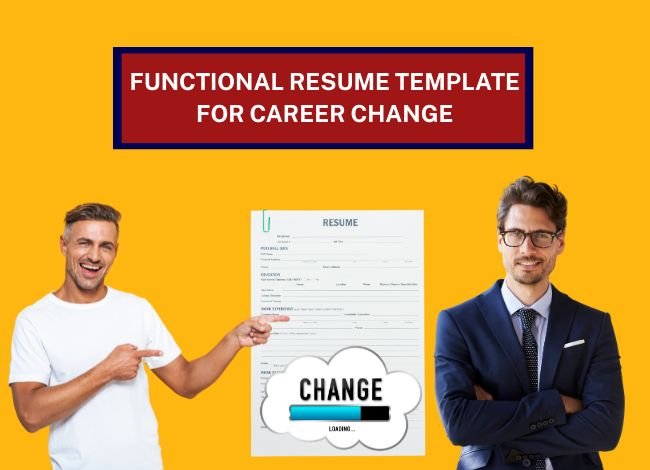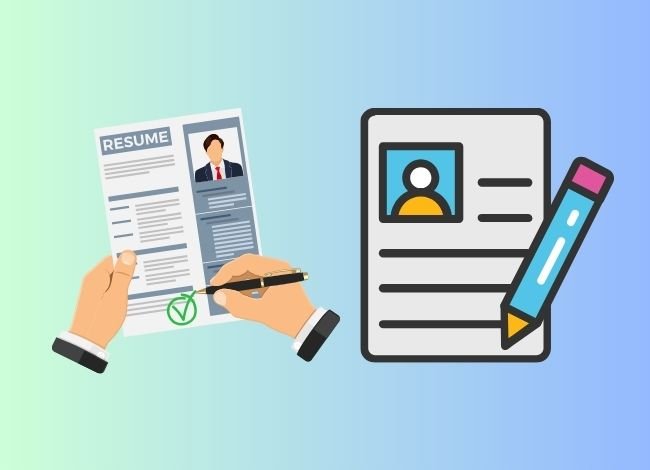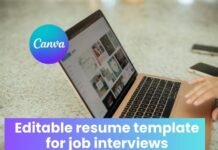 Making a career change is both exciting and intimidating. You may feel motivated to enter a new industry, but at the same time, you worry about whether employers will take your application seriously. Traditional chronological resumes, which focus heavily on past job titles and timelines, don’t always work in your favor during such transitions. If your previous career seems unrelated to your new path, recruiters might overlook your potential.
Making a career change is both exciting and intimidating. You may feel motivated to enter a new industry, but at the same time, you worry about whether employers will take your application seriously. Traditional chronological resumes, which focus heavily on past job titles and timelines, don’t always work in your favor during such transitions. If your previous career seems unrelated to your new path, recruiters might overlook your potential.
This is where a functional resume template for career change becomes highly effective. Unlike a chronological resume, the functional format emphasizes skills, abilities, and accomplishments rather than just your job history. By highlighting transferable skills, you can bridge the gap between your old career and your desired new role, making it easier for hiring managers to see your true value.
In today’s competitive job market, your resume isn’t just a document—it’s your first chance to prove you have what it takes to succeed, even if your career path is unconventional. This article will guide you through the concept of a functional resume, how to write one for a career change, and provide you with templates and examples that you can adapt for your own job search.
What is a Functional Resume?
A functional resume is a resume format that prioritizes skills and qualifications over chronological work history. Instead of listing jobs in order by date, it organizes information under skill categories such as “Leadership,” “Communication,” or “Technical Expertise.” This makes it easier for recruiters to focus on what you can do, rather than where and when you did it.
This type of resume is especially useful in situations where:
You are changing careers and want to emphasize transferable skills.
You have employment gaps that you don’t want to highlight.
You have diverse experience (freelance work, short-term contracts) that doesn’t fit neatly into a timeline.
You want to direct attention to strengths that match a specific job posting.
For example, if you’re moving from a teaching career into project management, your resume may highlight skills like leadership, organization, communication, and problem-solving, rather than focusing only on your years of teaching. Recruiters will quickly see that you possess the competencies they need, even if your job titles don’t perfectly align with the new role.
How to Write a Career Change Functional Resume
Switching industries can be challenging, but with the right resume strategy, you can highlight your strengths and demonstrate your value to potential employers. The key is to present transferable skills in a way that connects your past experiences with your future career goals. A functional resume format is ideal for this because it draws attention away from job titles and focuses on abilities.
Below are the steps to create a strong functional resume template for career change:
1. Research the Industry
Before writing anything, you must understand what your target industry is looking for. Go through job descriptions, LinkedIn profiles, and company websites to identify recurring keywords and skill requirements. For example:
If you are moving from retail to human resources, note skills like employee training, conflict resolution, and communication.
If you are shifting from teaching to corporate training, pay attention to terms such as curriculum design, leadership, and presentation skills.
By researching thoroughly, you’ll know exactly what to emphasize in your resume to align with industry expectations.
2. Review Your Experience
Think about your transferable skills—abilities that are valuable in any industry. Even if your previous role seems unrelated, you’ve likely gained experience that can apply elsewhere. For instance:
A teacher has organization, communication, and leadership skills that are useful in project management.
A customer service representative has problem-solving and client management experience, which translates well into sales or HR.
List these experiences and categorize them under broad skill areas. This exercise will help you structure the “Skills” section of your resume later.
3. Write an Objective Statement
Unlike a standard resume, a career-change functional resume benefits from an objective or summary statement at the top. This short section allows you to explain why you’re transitioning and what you can offer in your new career.
Example:
“Adaptable and detail-oriented professional with 6 years of experience in education, now seeking to transition into project management. Skilled in leadership, communication, and organizational planning, with a proven ability to deliver results and manage teams effectively.”
This type of statement reassures employers that you are serious about the shift and already have the skills to succeed.
4. Outline Relevant Skills
The most important section of a functional resume for career change is the skills-based format. Instead of leading with job titles, you highlight abilities that directly relate to your new career path. This allows recruiters to focus on what you can do, rather than where you have worked.
Organize your skills into categories, and under each one, provide supporting examples. For instance:
Leadership and Team Collaboration
Directed a group of colleagues to complete time-sensitive projects.
Trained and mentored new employees, improving overall productivity.
Problem-Solving and Critical Thinking
Streamlined processes that reduced errors and improved efficiency.
Analyzed challenges in workflow and implemented solutions that cut delays by 20%.
Communication and Interpersonal Skills
Delivered presentations to large groups with clarity and confidence.
Handled sensitive conversations with empathy, ensuring positive outcomes.
This structure ensures that even if your job titles do not match the role you are applying for, recruiters immediately recognize your transferable strengths.
5. Include Professional Experience
Although your career-change resume should focus on skills, you should still include a professional experience section. The goal here is not to list every responsibility but to briefly show employment history and credibility. Keep it simple: job title, company name, and dates.
Example:
Customer Service Manager – ABC Retail – 2018–2023
Customer Service Associate – XYZ Store – 2015–2018
By keeping this section concise, you demonstrate stability and accountability without drawing too much attention to unrelated roles.
6. List Education
Education becomes more important during a career transition, especially if you’ve taken additional courses, workshops, or certifications related to your new field.
For example:
Google Project Management Certificate – 2024
Bachelor of Arts in English – 2015
If your degree is not directly related to your new career, highlight coursework, training, or certifications that are. This shows employers you are committed to building expertise in your chosen path.
7. Consider Additional Sections
A functional resume gives you flexibility, which means you can add optional sections that strengthen your application and highlight your commitment to a new career path. These sections can make a big difference when hiring managers compare candidates with similar skill sets.
Some valuable additions include:
Certifications & Training
If you’ve taken courses or earned certifications related to your new industry, showcase them. For example, a Google Analytics certificate can help if you’re moving into marketing, while a Scrum Master certification supports a shift into project management.
Volunteer Work
Volunteer experience can demonstrate passion and skills relevant to your new career. For example, volunteering as an event coordinator for a local nonprofit proves your organizational and leadership skills.
Projects
Independent or freelance projects are powerful, especially if they connect directly to your desired role. Listing a website you designed, a campaign you managed, or a training program you created gives tangible proof of your abilities.
Professional Affiliations
Membership in industry-related associations shows genuine interest. If you’re transitioning into HR, joining a local HR association will make you stand out.
These sections are not mandatory, but they provide additional credibility and demonstrate that you’re actively building expertise in your new career.
8. Proofread Your Resume
Even the most impressive skills can be overshadowed by poor formatting or errors. Before submitting, ensure your resume is polished and professional. Pay attention to:
Grammar and spelling: Typos immediately reduce credibility.
Consistency: Use the same font, bullet style, and tense throughout.
ATS optimization: Incorporate keywords from job descriptions naturally.
Readability: Keep sentences concise and use active language.
It’s also wise to ask someone else—a mentor, career coach, or trusted friend—to review your resume. A fresh perspective often catches mistakes you might miss.
Template for Career Change Functional Resume
When making a career change, structure matters. A functional resume works best because it brings skills and transferable achievements to the forefront. Below is a professional functional resume template for career change that you can adapt to your situation.
[Full Name]
[Email Address] | [Phone Number] | [LinkedIn Profile] | [City, State]
Objective / Summary
Write a brief 3–4 sentence introduction that explains your career change, highlights your strongest skills, and connects them to the new role.
Example: Results-driven professional with 8 years of experience in customer service, now seeking to transition into human resources. Skilled in communication, conflict resolution, and leadership, with a proven record of improving team efficiency.
Key Skills
(Choose 3–4 main skill categories and add achievements under each one)
Leadership & Management
Coordinated teams to complete projects on time and under budget.
Mentored and trained new employees, improving retention rates.
Problem-Solving & Analysis
Developed strategies that reduced operational costs by 15%.
Resolved client concerns quickly, achieving 95% satisfaction ratings.
Communication & Interpersonal Skills
Delivered presentations to diverse audiences with clarity.
Handled sensitive negotiations, building long-term relationships.
Professional Experience
(Keep this section brief—list only job title, company, and dates. Do not overemphasize unrelated duties.)
Job Title – Company – Dates
Job Title – Company – Dates
Education
(Include relevant degrees, certifications, or training)
Degree / Certification – Institution – Year
Additional relevant coursework or licenses
Additional Sections (Optional)
Certifications: Any industry-specific training (e.g., Project Management Certificate).
Volunteer Work: Demonstrates initiative and transferable skills.
Projects: Independent work showcasing skills relevant to your new career.
Awards or Achievements: Recognition that adds credibility.
This structure ensures recruiters immediately see your strengths, while still including essential background details. By putting skills first and keeping unrelated work history minimal, the template makes it easier to prove you’re ready for a new industry.
Example of Career Change Functional Resume
Here’s a sample functional resume template for career change to give you a clear idea of how your finished document should look.
Jane Smith
jane.smith@email.com | (555) 123-4567 | LinkedIn.com/in/janesmith | Chicago, IL
Objective
Dedicated professional with 7 years in customer service, now seeking to transition into Human Resources. Strong communication, conflict resolution, and organizational skills with proven ability to foster a positive workplace environment.
Key Skills
Communication & Interpersonal Abilities
Trained and coached over 20 new employees, improving onboarding efficiency.
Handled customer concerns with empathy, increasing satisfaction ratings by 30%.
Leadership & Organization
Supervised a retail team of 10 employees, overseeing schedules and performance.
Coordinated day-to-day operations to maintain smooth workflows.
Conflict Resolution & Problem-Solving
Resolved escalated issues successfully, de-escalating 95% of conflicts.
Introduced a new reporting system that reduced complaint resolution time by 25%.
Professional Experience
Customer Service Manager – ABC Retail – 2017–2023
Customer Service Associate – XYZ Retail – 2014–2017
Education
Bachelor of Science in Business Administration – University of Illinois – 2014
Additional Sections
Certified HR Assistant Training Program – 2023
Volunteer HR Coordinator, Local Nonprofit – 2022
This example demonstrates how to place skills front and center, while keeping the work history section brief. The result is a resume that tells employers: “I may be changing careers, but I already have the skills to succeed in this new field.”
Conclusion
Making a career change can feel daunting, but the right resume format can open doors. A functional resume template for career change allows you to highlight transferable skills, downplay unrelated job history, and show employers you are capable of thriving in a new industry.
By carefully researching your target field, crafting a compelling objective statement, and showcasing your most relevant abilities, you can present yourself as a strong candidate—even without direct experience.
Remember, the key is not to hide your past but to reframe it. A well-written functional resume bridges the gap between where you’ve been and where you want to go. With a polished, skill-focused resume, your career change will no longer feel like a risk—it will look like a smart, strategic step forward.

